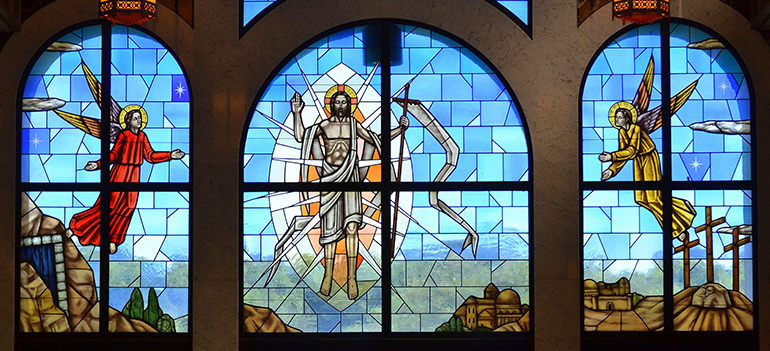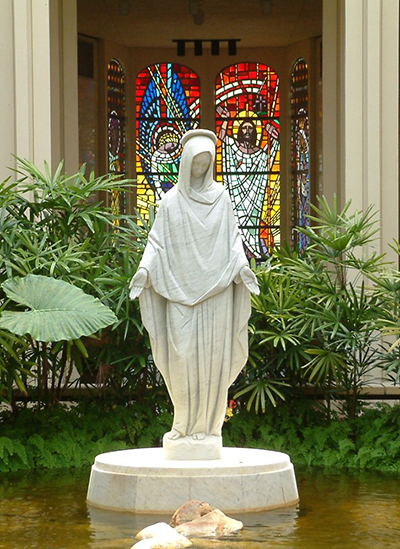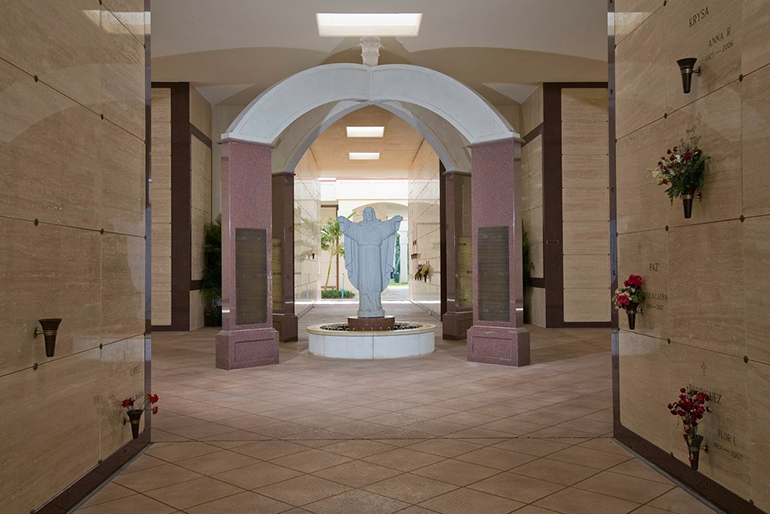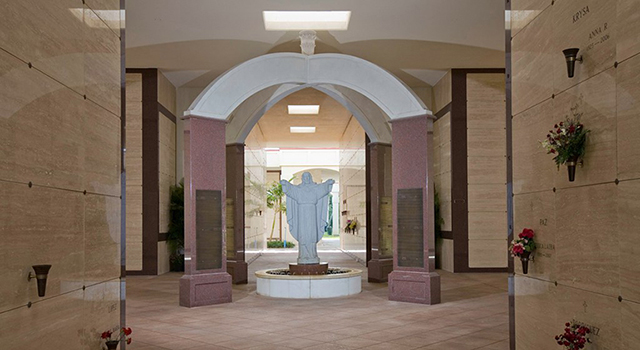By Ana Rodriguez Soto - Florida Catholic newspaper

Photographer: Jim Davis
The risen Jesus is attended by angels in this triptych at Queen of Heaven Cemetery in North Lauderdale. It's a reminder, as Cardinal Gerhard Muller said, that “the burial, the last liturgy for us, is an expression of our hope for the resurrection.”
Vatican City (CNA/EWTN News) | The Congregation for the Doctrine of the Faith has released an instruction regarding burial and cremation, reiterating the Church's teaching that cremation, while strongly discouraged, can be permissible under certain restrictions
Ad
The document explains that after “legitimate motives” for cremation have been ascertained, the “ashes of the faithful must be laid to rest in a sacred place,” such as in a cemetery or church. It goes on to state that is not permitted to keep the ashes in a home or to scatter them “in the air, on land, at sea or in some other way, nor may they be preserved in mementos, pieces of jewelry or other objects.”
“The burial, the last liturgy for us, is an expression of our hope for the resurrection,” Cardinal Gerhard Müller, prefect of the congregation wrote, “and therefore the Church continues to teach that the normal burial of the body is the normal form.”
Faith in the resurrection
As the document explains, “by burying the bodies of the faithful, the Church confirms her faith in the resurrection of the body, and intends to show the great dignity of the human body as an integral part of the human person whose body forms part of their identity.”
“She cannot, therefore, condone attitudes or permit rites that involve erroneous ideas about death, such as considering death as the definitive annihilation of the person, or the moment of fusion with Mother Nature or the universe.”

Photographer: COURTESY PHOTO |
This statue of Our Lady of Mercy welcomes visitors to the chapel at Our Lady of Mercy Cemetery in Miami. Catholic Cemeteries of the Archdiocese of Miami embody the words of the new Vatican document by providing a dignified burial place and "a setting which promotes a oneness with God."
Rather, burial in a cemetery or another sacred place “adequately corresponds to the piety and respect owed to the bodies of the faithful departed who through Baptism have become temples of the Holy Spirit and in which ‘as instruments and vessels the Spirit has carried out so many good works.’”
"The message expressed in the document has been the essence of our mission since these sacred grounds were consecrated in 1959, and the focus of our educational work within the parishes," said Mary Jo Frick, executive director of Catholic Cemeteries
She noted that Our Lady of Mercy in Doral, Our Lady Queen of Heaven in North Lauderdale, and the parishes in the Keys that offer Catholic burial and columbaria for cremation "embody the words of the document, with chapels for the celebration of Mass and private prayer, and ... (a) setting which promotes a oneness with God."
Question answered in 1963
The Vatican originally answered the question of whether or not cremation was allowed in 1963, but with the increase in both its popularity and in practices such as scattering the ashes or keeping them in the home, it found it necessary to provide a new set of norms as guidance for bishops.
The instruction emphasized that “following the most ancient Christian tradition, the Church insistently recommends that the bodies of the deceased be buried.”
A proper respect for the dignity of the body, according to Father Thomas Bonino, an official at the CDF, promotes the hylomorphic understanding of the human person as being composed of both body and soul.
“One must perhaps start from the idea of ecology,” Father Bonino told CNA, “meaning respect for nature. But the body is part of our nature, so a true ecology is also an ecology which takes into account the corporality of man.”
Father Bonino explained that because “the body forms part of our identity” together with the soul, this teaching “must be reaffirmed” in preaching and in catechesis.
Practices such as scattering the ashes in nature can be a form of “pantheistic
The new norms address these issues, he said, while also reacting against the idea that death is only about the individual or the immediate family. “Death also deals with the community to which the deceased belonged,” he pointed out.
Corporal work of mercy
The Vatican document highlighted several other reasons for the importance of the burial of the dead, including that the Church considers burying the dead to be one of the corporal works of mercy.
“From the earliest times, Christians have desired that the faithful departed become the objects of the Christian community’s prayers and remembrance. Their tombs have become places of prayer,
By reserving the ashes of the deceased in a sacred place, we can be assured that they are not excluded from the prayers of their family and the Christian community, it continued, as well as provide a more permanent marker for posterity, especially after the immediately subsequent generation has passed away.
“We are Catholics … and we must try to understand all elements of our life in the sense of the Christian faith,” Cardinal Müller said.“We believe in the resurrection of Jesus Christ our Lord and also we have the hope for our resurrection of our body… And therefore the big tradition as Christians has always been

Photographer: COURTESY PHOTO |
This statue of the Sacred Heart welcomes visitors to the Christ the King mausoleum at Our Lady of Mercy Cemetery in Doral. Catholic Cemeteries of the Archdiocese of Miami embody the words of the new Vatican document by providing a dignified burial place and "a setting which promotes a oneness with God."

